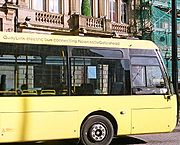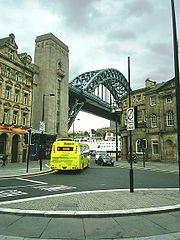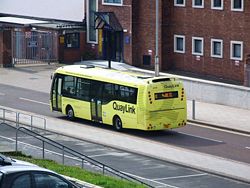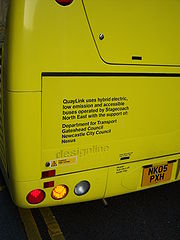
QuayLink
Encyclopedia
Quaylink is a bus
service in Tyne and Wear
, England
, operated by Go North East
under contract to Newcastle and Gateshead Councils and Nexus
.
Quaylink links both the Newcastle and Gateshead Quayside
area of the River Tyne
with the centres of Newcastle upon Tyne
and Gateshead
and to the other local public transport
bus, metro and rail modes. The service provides transport for local residents and for the users of the various tourist attractions of the Quayside, and for night time users of the many Quayside bars and restaurants.
The Quaylink service was introduced as a high quality public transport
service for the redeveloped and expanding Quayside area, which, although extremely close to Newcastle and Gateshead town centres, were either not served, or not well served, by conventional bus
transport, and dominated by car usage. The Quayside roads are also not located on any of the traditional bus
routes.
The service was originally operated with accessible hybrid diesel-electric buses
with a distinctive appearance, enhanced by a special yellow livery. They were replaced in August 2010 by new low-emission diesel buses.
 In June 2002, Newcastle and Gateshead councils and Nexus invited tenders for operation of a proposed Tyne Quayside Link, and for manufacture of eight alternatively-fuelled buses for a Quayside Transit System. The total project, scheduled for launch in 2004, would cost £5m, with £3m coming from the local transport plan, £1m from regeneration funds for Gateshead, and £1m from the Quayside developers. As well as new buses, the project involved the construction of a bus lane
In June 2002, Newcastle and Gateshead councils and Nexus invited tenders for operation of a proposed Tyne Quayside Link, and for manufacture of eight alternatively-fuelled buses for a Quayside Transit System. The total project, scheduled for launch in 2004, would cost £5m, with £3m coming from the local transport plan, £1m from regeneration funds for Gateshead, and £1m from the Quayside developers. As well as new buses, the project involved the construction of a bus lane
and improvements to some bus stop
s, making them fully accessible.
The Quaylink service was launched on 22 July 2005 as a week-long free shuttle service to coincide with the 2005 Tall Ships Race , with the full service commencing on 29 July 2005. Prior to launch, all ten buses were pictured on the Quayside with local dignitaries and partner representatives.
The service cost £8m to set up and initially passenger numbers were low; carrying just 11,000 passengers a week. But ridership increased, and by 31 May 2007 the Quaylink services had carried 1 million passengers
Following development of the Ouseburn valley, on 3 September 2007 the Q2 service was extended to the St Peter's Basin area to the east
On 18 July 2010 operations transferred to Go North East
under a five year contract. It was announced that the hybrid vehicles used on the route would be replaced by new diesel buses owing to their difficulty coping with hills on the route. On 10 August 2010, new Optare Versa
single-deckers were introduced to the route.

 QuayLink operates as two routes, Q1 and Q2. Both routes share a common north/south section in Newcastle city centre, from the Theatre Royal at the north end, down Grey Street to the Newcastle bank of the Tyne at the Guildhall. At the Theatre Royal end, Q1 continues to Central Station, Q2 continues to Haymarket. At the Tyne end, Q2 proceeds along the Newcastle Quayside, with a long one way section meaning outbound buses proceed through the nearby inland streets, and returning buses travel along the Quayside front. Q1 proceeds over the Tyne on the Swing Bridge, and along the Gateshead Quayside, before turning south to Gateshead.
QuayLink operates as two routes, Q1 and Q2. Both routes share a common north/south section in Newcastle city centre, from the Theatre Royal at the north end, down Grey Street to the Newcastle bank of the Tyne at the Guildhall. At the Theatre Royal end, Q1 continues to Central Station, Q2 continues to Haymarket. At the Tyne end, Q2 proceeds along the Newcastle Quayside, with a long one way section meaning outbound buses proceed through the nearby inland streets, and returning buses travel along the Quayside front. Q1 proceeds over the Tyne on the Swing Bridge, and along the Gateshead Quayside, before turning south to Gateshead.
 From its launch until July 2010, the QuayLink services used ultra low emission hybrid gas-turbine/electric vehicles, with a markedly quiet ride. The vehicles were Designline
From its launch until July 2010, the QuayLink services used ultra low emission hybrid gas-turbine/electric vehicles, with a markedly quiet ride. The vehicles were Designline
Olymbuses, from New Zealand. An initial vehicle was imported by Stagecoach. It arrived by sea in October 2004 and toured the country in their house colours on proving trials until April 2005. The bus fleet was added to, totalling 10 vehicles, which operated from the Walkergate depot. The vehicles were substantially modified for operation in the UK, notably using a leaf door design over the plug design. While the buses were double doored, the middle door was only provided for wheelchair
access. Two Dennis Dart
s were used as spare buses.
When the route's contract came up for renewal in summer 2010, it was decided that the Olympuses should be replaced because of difficulties coping with the hilly nature of the route. Go North East took over operation of the route in July 2010, and conventional buses were used on the route for the first three weeks. Nine new Optare Versa
single-deckers, which Go North East and Newcastle City Council say are more environmentally friendly that the hybrid vehicles, replaced them from 10 August 2010. These vehicles feature increased seating capacity, information screens and audio announcements. Real-time information has also been provided at bus stops on the route.
Bus
A bus is a road vehicle designed to carry passengers. Buses can have a capacity as high as 300 passengers. The most common type of bus is the single-decker bus, with larger loads carried by double-decker buses and articulated buses, and smaller loads carried by midibuses and minibuses; coaches are...
service in Tyne and Wear
Tyne and Wear
Tyne and Wear is a metropolitan county in north east England around the mouths of the Rivers Tyne and Wear. It came into existence as a metropolitan county in 1974 after the passage of the Local Government Act 1972...
, England
England
England is a country that is part of the United Kingdom. It shares land borders with Scotland to the north and Wales to the west; the Irish Sea is to the north west, the Celtic Sea to the south west, with the North Sea to the east and the English Channel to the south separating it from continental...
, operated by Go North East
Go North East
Go North East is the largest operator of bus services in North East England, United Kingdom. Go North East operates services in the counties of Tyne and Wear, County Durham and Northumberland...
under contract to Newcastle and Gateshead Councils and Nexus
Tyne and Wear Passenger Transport Executive
The Tyne and Wear Passenger Transport Executive using the brandname of Nexus, is the Passenger Transport Executive for the Tyne and Wear region of North East England....
.
Quaylink links both the Newcastle and Gateshead Quayside
Quayside
The Quayside is an area along the banks of the River Tyne in Newcastle upon Tyne and Gateshead in the North East of England, United Kingdom....
area of the River Tyne
River Tyne
The River Tyne is a river in North East England in Great Britain. It is formed by the confluence of two rivers: the North Tyne and the South Tyne. These two rivers converge at Warden Rock near Hexham in Northumberland at a place dubbed 'The Meeting of the Waters'.The North Tyne rises on the...
with the centres of Newcastle upon Tyne
Newcastle upon Tyne
Newcastle upon Tyne is a city and metropolitan borough of Tyne and Wear, in North East England. Historically a part of Northumberland, it is situated on the north bank of the River Tyne...
and Gateshead
Gateshead
Gateshead is a town in Tyne and Wear, England and is the main settlement in the Metropolitan Borough of Gateshead. Historically a part of County Durham, it lies on the southern bank of the River Tyne opposite Newcastle upon Tyne and together they form the urban core of Tyneside...
and to the other local public transport
Public transport
Public transport is a shared passenger transportation service which is available for use by the general public, as distinct from modes such as taxicab, car pooling or hired buses which are not shared by strangers without private arrangement.Public transport modes include buses, trolleybuses, trams...
bus, metro and rail modes. The service provides transport for local residents and for the users of the various tourist attractions of the Quayside, and for night time users of the many Quayside bars and restaurants.
The Quaylink service was introduced as a high quality public transport
Public transport
Public transport is a shared passenger transportation service which is available for use by the general public, as distinct from modes such as taxicab, car pooling or hired buses which are not shared by strangers without private arrangement.Public transport modes include buses, trolleybuses, trams...
service for the redeveloped and expanding Quayside area, which, although extremely close to Newcastle and Gateshead town centres, were either not served, or not well served, by conventional bus
Bus
A bus is a road vehicle designed to carry passengers. Buses can have a capacity as high as 300 passengers. The most common type of bus is the single-decker bus, with larger loads carried by double-decker buses and articulated buses, and smaller loads carried by midibuses and minibuses; coaches are...
transport, and dominated by car usage. The Quayside roads are also not located on any of the traditional bus
Bus
A bus is a road vehicle designed to carry passengers. Buses can have a capacity as high as 300 passengers. The most common type of bus is the single-decker bus, with larger loads carried by double-decker buses and articulated buses, and smaller loads carried by midibuses and minibuses; coaches are...
routes.
The service was originally operated with accessible hybrid diesel-electric buses
Hybrid electric bus
A hybrid electric bus combines a conventional internal combustion engine propulsion system with an electric propulsion system. These type of buses normally use a diesel-electric powertrain and are also known as hybrid diesel-electric buses....
with a distinctive appearance, enhanced by a special yellow livery. They were replaced in August 2010 by new low-emission diesel buses.
History

Bus lane
A bus lane or bus only lane is a lane restricted to buses, and generally used to speed up public transport that would be otherwise held up by traffic congestion...
and improvements to some bus stop
Bus stop
A bus stop is a designated place where buses stop for passengers to board or leave a bus. These are normally positioned on the highway and are distinct from off-highway facilities such as bus stations. The construction of bus stops tends to reflect the level of usage...
s, making them fully accessible.
The Quaylink service was launched on 22 July 2005 as a week-long free shuttle service to coincide with the 2005 Tall Ships Race , with the full service commencing on 29 July 2005. Prior to launch, all ten buses were pictured on the Quayside with local dignitaries and partner representatives.
The service cost £8m to set up and initially passenger numbers were low; carrying just 11,000 passengers a week. But ridership increased, and by 31 May 2007 the Quaylink services had carried 1 million passengers
Following development of the Ouseburn valley, on 3 September 2007 the Q2 service was extended to the St Peter's Basin area to the east
On 18 July 2010 operations transferred to Go North East
Go North East
Go North East is the largest operator of bus services in North East England, United Kingdom. Go North East operates services in the counties of Tyne and Wear, County Durham and Northumberland...
under a five year contract. It was announced that the hybrid vehicles used on the route would be replaced by new diesel buses owing to their difficulty coping with hills on the route. On 10 August 2010, new Optare Versa
Optare Versa
The Optare Versa is a midibus built by Optare in its Leeds factory. It was officially launched in Britain at the Euro Bus Expo 2006 at the NEC, Birmingham, on 7 November 2006, with the first order of 25 buses being placed by Stagecoach on the same day....
single-deckers were introduced to the route.
Routes


Q1
- Central Station
- Grainger StreetGrainger TownGrainger Town is the historic heart of Newcastle upon Tyne, England.Based around classical streets built by Richard Grainger, a builder and developer, between 1824 and 1841, some of Newcastle upon Tyne's finest buildings and streets lie within the Grainger Town area of the City centre including...
- Theatre RoyalTheatre Royal, NewcastleThe Theatre Royal is a Grade I listed building situated on Grey Street in Newcastle upon Tyne. It was designed by local architects John and Benjamin Green as part of Richard Grainger's grand design for the centre of Newcastle, and was opened on 20 February 1837 with a performance of The Merchant...
- Grey Street
- Dean Street
- Newcastle Guildhall
- Theatre Royal
- Over the Swing BridgeSwing Bridge, River TyneThe Swing Bridge is a swing bridge over the River Tyne, England connecting Newcastle upon Tyne and Gateshead, and lies between the Tyne Bridge and the High Level Bridge. The hydraulic power to move the bridge is derived from electrically driven pumps...
- The Sage (north side)
- The Baltic CentreBALTIC Centre for Contemporary ArtThe Baltic Centre for Contemporary Art is an international centre for contemporary art located on the south bank of the River Tyne alongside the Gateshead Millennium Bridge in Gateshead, North East England, United Kingdom...
- The Sage (south side)
- GatesheadGatesheadGateshead is a town in Tyne and Wear, England and is the main settlement in the Metropolitan Borough of Gateshead. Historically a part of County Durham, it lies on the southern bank of the River Tyne opposite Newcastle upon Tyne and together they form the urban core of Tyneside...
High Street - Gateshead InterchangeGateshead InterchangeGateshead Interchange is a transport interchange in the centre of the town of Gateshead, England. It is served by the Tyne and Wear Metro, whose station is underground, as well as local bus services...
Q2
- Haymarket bus stationHaymarket Bus StationHaymarket bus station is one of two bus stations serving the city centre of Newcastle upon Tyne, North East England.Originally opened in 1930, refurbished in the early 1970s and rebuilt in 1997, it is located in the Haymarket area of the city centre, near to Newcastle University and adjacent to the...
- Newcastle Civic CentreNewcastle Civic CentreNewcastle Civic Centre is a civic centre located in the Haymarket area of Newcastle upon Tyne, England. It is the main administrative and ceremonial centre for Newcastle City Council. Designed by the city architect, George Kenyon, the building was completed in 1967 and was formally opened by HM...
- John DobsonJohn Dobson (architect)John Dobson was a 19th-century English architect in the neoclassical tradition. He became the most noted architect in the North of England. Churches and houses by him dot the North East - Nunnykirk Hall, Meldon Park, Mitford Hall, Lilburn Tower, St John the Baptist Church in Otterburn,...
Street - Laing Art GalleryLaing Art GalleryThe Laing Art Gallery in Newcastle upon Tyne, England is located on New Bridge Street. It was opened in 1904 and is now managed by Tyne & Wear Archives & Museums and sponsored by the Department for Culture, Media and Sport. In front of the gallery is the Blue Carpet.The gallery holds oil paintings,...
- Theatre RoyalTheatre Royal, NewcastleThe Theatre Royal is a Grade I listed building situated on Grey Street in Newcastle upon Tyne. It was designed by local architects John and Benjamin Green as part of Richard Grainger's grand design for the centre of Newcastle, and was opened on 20 February 1837 with a performance of The Merchant...
- Grey Street
- Dean Street
- Newcastle Guildhall
- Theatre Royal
- Quayside (road)
- Law Courts
- OuseburnOuseburnThe Ouseburn is a river which flows through Newcastle upon Tyne into the River Tyne. The river gives its name to the Ouseburn electoral ward....
(eastbound via Byker Bank and Walker Road, westbound via Quayside) - St. Peters Basin
Vehicles

Designline
DesignLine Corporation is a bus, coach, and trolleybus manufacturer founded in Ashburton, New Zealand in 1985. Initially it was a manufacturer of tour coaches, later it diversified into city buses in the early 1990s, and then to hybrid city buses in the late 1990s...
Olymbuses, from New Zealand. An initial vehicle was imported by Stagecoach. It arrived by sea in October 2004 and toured the country in their house colours on proving trials until April 2005. The bus fleet was added to, totalling 10 vehicles, which operated from the Walkergate depot. The vehicles were substantially modified for operation in the UK, notably using a leaf door design over the plug design. While the buses were double doored, the middle door was only provided for wheelchair
Wheelchair
A wheelchair is a chair with wheels, designed to be a replacement for walking. The device comes in variations where it is propelled by motors or by the seated occupant turning the rear wheels by hand. Often there are handles behind the seat for someone else to do the pushing...
access. Two Dennis Dart
Dennis Dart
The Dennis Dart is a rear-engined midibus built by Dennis in the United Kingdom. More than 11,000 were built during 18 years of production....
s were used as spare buses.
When the route's contract came up for renewal in summer 2010, it was decided that the Olympuses should be replaced because of difficulties coping with the hilly nature of the route. Go North East took over operation of the route in July 2010, and conventional buses were used on the route for the first three weeks. Nine new Optare Versa
Optare Versa
The Optare Versa is a midibus built by Optare in its Leeds factory. It was officially launched in Britain at the Euro Bus Expo 2006 at the NEC, Birmingham, on 7 November 2006, with the first order of 25 buses being placed by Stagecoach on the same day....
single-deckers, which Go North East and Newcastle City Council say are more environmentally friendly that the hybrid vehicles, replaced them from 10 August 2010. These vehicles feature increased seating capacity, information screens and audio announcements. Real-time information has also been provided at bus stops on the route.
External links
- Newcastle Council QuayLink page
- Stagecoachbus.com QuayLink page
- Nexus QuayLink press images
- Stagecoachbus.com QuayLink Route map September 2007
- Nexus QuayLink map and leaflet, September 2007

